

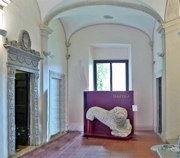
Entrance on Ground Floor
Lion (1st or 2nd century AD)
The marble lion displayed near the entrance to the museum, which probably formed part of a funerary monument, was found in 1930 near the Largo del Recentino (outside Narni).
Stone Age Remains
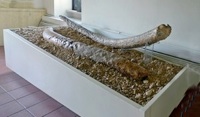
The collection includes two tusks of Elephas antiquus (straight-tusked elephants) found in a cave at Ripabianca, near Taizzano in 1989.
A poster display records the discovery of the fossilised skeleton of a Stephanorhinus etruscus (ancient rhinocerus) in 1962 at Capitone. These remains, which represent the most complete skeleton of this mammal ever found, are in the Museo di Paleontologia dell’ Università “la Sapienza”, Rome.
Remains from the Late Bronze Age

Roman Remains
Finds (150 - 75 AD)


These remains of household objects were found in 1983 during the excavation of what seems to have been a refuse dump in what is now Piazza Cavour (see Walk I). The objects include a number of amphorae, which would originally have contained imported oil and wine.
Marble Statues (1st century BC)
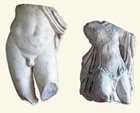
-
✴Apollo; and
-
✴a maenad (female follower of Bacchus).
Funerary plaque (1st century BC)
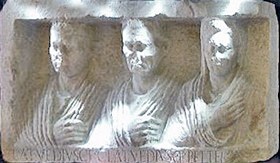
This plaque [on the back wall] contains sculpted busts of two men and a woman. The inscriptions below name the deceased:
C LATVEDIVS C(AII) F(ILIUS); C LATVEDIVS C(AII) F(ILIUS); PETTER
This commemorate Caius Latuedius, son of Caius; another man of the same name who was presumably his son; and Pettia, who was presumably the wife of the first Caius Latuedius and mother of the second.
Inscription (1st century BC)

This architrave from a funerary monument was found in 1930 near Ponte Caldaro (a bridge on Via Flaminia, north of the present Narni Scalo). It carries a long inscription that offers good wishes to those who refrain from writing on the monument during an election campaign:
Ita candidatus quod petit fiat tuus
Et ita perennes scriptor opus hoc praeteri
Hoc si impetro ad felix vivat benevale
Funerary Inscription (1st century BC)

C(AIUS) LINDIVS C(AII) F(ILIUS)
M(ARCUS) VALERIVS P(UBLII) F(ILIUS)
IIII VIRI AED
D(E) S(UO)
It records the largesse of two of the quattuorviri aediles: Caius Lindius, son of Caius and Marcus Valerius, son of Publius.
Funerary Inscription (1st or 2nd century AD)
This fragment of a marble inscription was found in 1861 embedded in a well near Santa Maria Impensole. It reads:
[D]VLCIS NIMIS PROLE[S]
[S]PES SOLACIA NOSTR[A]
[Q]VI TANTVM MISERIS TR[IBVISTIS]
[P]ARENTIBVS IGNEM HIC PR. . .
[IA]CET FATIS ER[E]PTVS NEFANDI[S]
[VIXIT ANNIS. . .] MENS(IBUS) DEC[EM]
Although fragmentary, the sense of the inscription is clear: "sweetest child, our comfort and hope, whom fire has taken from his unlucky parents, wicked fate snatched you away".
Inscription (56 AD)
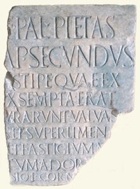
Inscription (1st century AD)
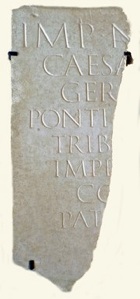
Funerary Inscription (1st century AD)
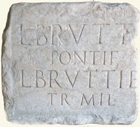
Funerary Inscription (1st century AD)

Funerary Inscription (1st century AD)
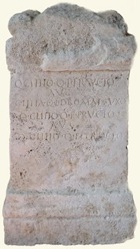
Funerary Inscription (1st or 2nd century AD)

L(UCIUS) AERVSSIO C(AII) F(ILIUS)RVFO
IIII VIRO AED SALVIAE M F SECVNDAE
FILIVS FECIT
It records that Lucius Aerussius Rufus, son of Lucius erected a monument for his father, Lucius Aerussius Rufus, son of Caius, who had been one of the quattuorviri aediles, nd his mother, Salvia M[arci], daughter of Secundia. This monument seems to have been erected on a rural property belonging to the family.
Inscribed Base of a Statue (before 370 AD)
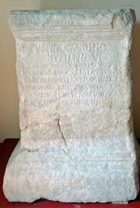
[Iuli]anii / P(ublio) Publilio Caeionio / Iuliano,
v(iro) c(larissimo)
correctori Tusciae et Umbriae
ob insigni eius gesta et inlus/tre administrationis meritum
ordo Narniensium una cum civibus statuam conlocave/runt
patrono dignissimo
It records the dedication of a statue (now lost) of Publius Publilius Caeionius Iulianus, of clarissimus rank, who was governor (corrector) of the Province of Tuscia et Umbria. The last lines of the inscription record that the statue had been erected by the city council and the people of Narnia to reward the remarkable achievements and distinguished service of their most worthy patron. The inscription must pre-date 370 AD, when the title of governor of the province was changed from “corrector” to “consularis”.
The inscription is also described in the page Inscriptions from Umbria in the Roman Empire.
Finds (1st - 5th centuries AD)
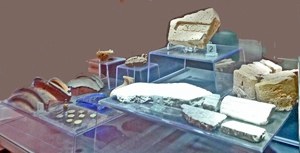
This material came from the excavations carried out in 1992-3 at Case Salietto, near Narni, which unearthed a funerary monument and a wayside station and baths. It includes:
-
✴a tile (1st century AD - number 2) with a manufacturer’s mark: “C CLODEI”;
-
✴a collection of bronze coins (3rd - 5th centuries BC)’and
-
✴floor tiles (ca. 400 AD) from the pavement of the baths.
Finds (5th and 6th centuries AD)
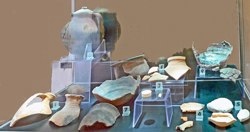
These remains of household objects were found in 1998 during the restoration of the fountain in Piazza dei Priori (see below).
Medieval Artefacts
Carolingian Altar (9th century)
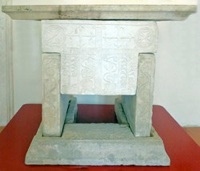
This altar was originally in San Martino di Taizzano, outside Narni. It was found in a henhouse near the ruined church in 1956 and moved to San Domenico for safekeeping. San Martino has been recently restored, and now has a copy in place of the original altar (see Narni News, 2nd November 2004).
Reliefs (12th century)
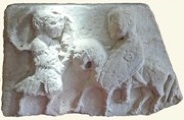
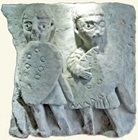
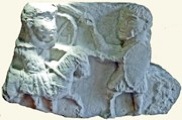
These three reliefs, which are of unknown provenance, depict scenes 0f combat that involve mounted knights and infantrymen.
Reliefs (13th century)
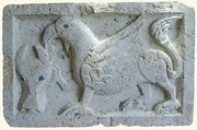
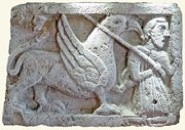
These two reliefs, which are of unknown provenance, depict the griffin of Narni imposing the submission of (respectively) a cow and a man.
Relief (13th century)
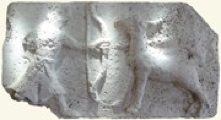
This relief, which is of unknown provenance, depicts a hunter aiming an arrow at a dear.
Capitals (12th century)
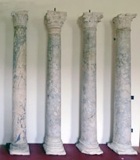
Basin from the Civic Fountain (1303)
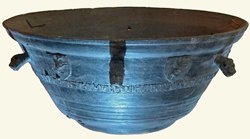

The six protruding cats’ heads under the lip of the basin acted as water spouts, and reliefs of the arms of Narni are sculpted between them.

